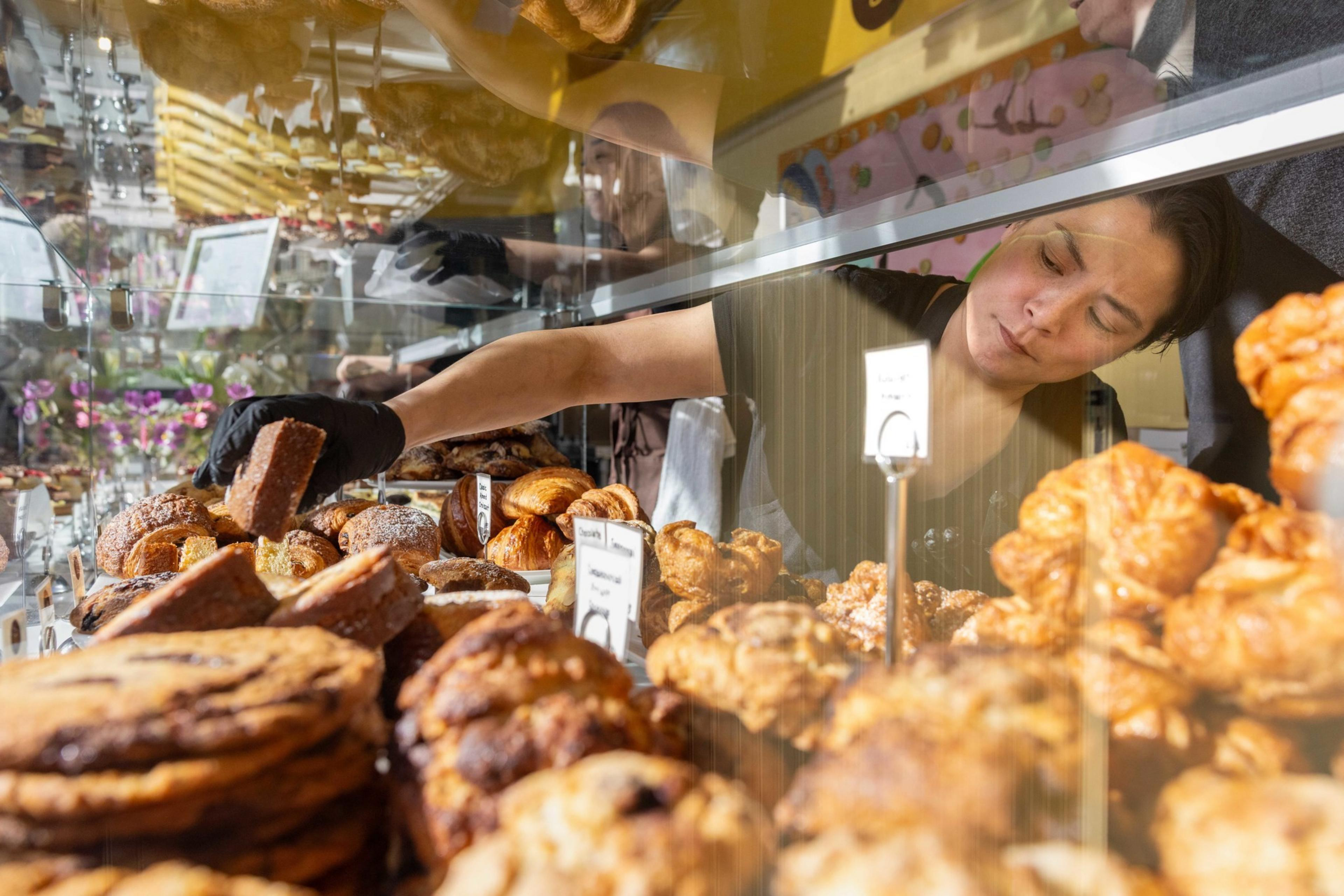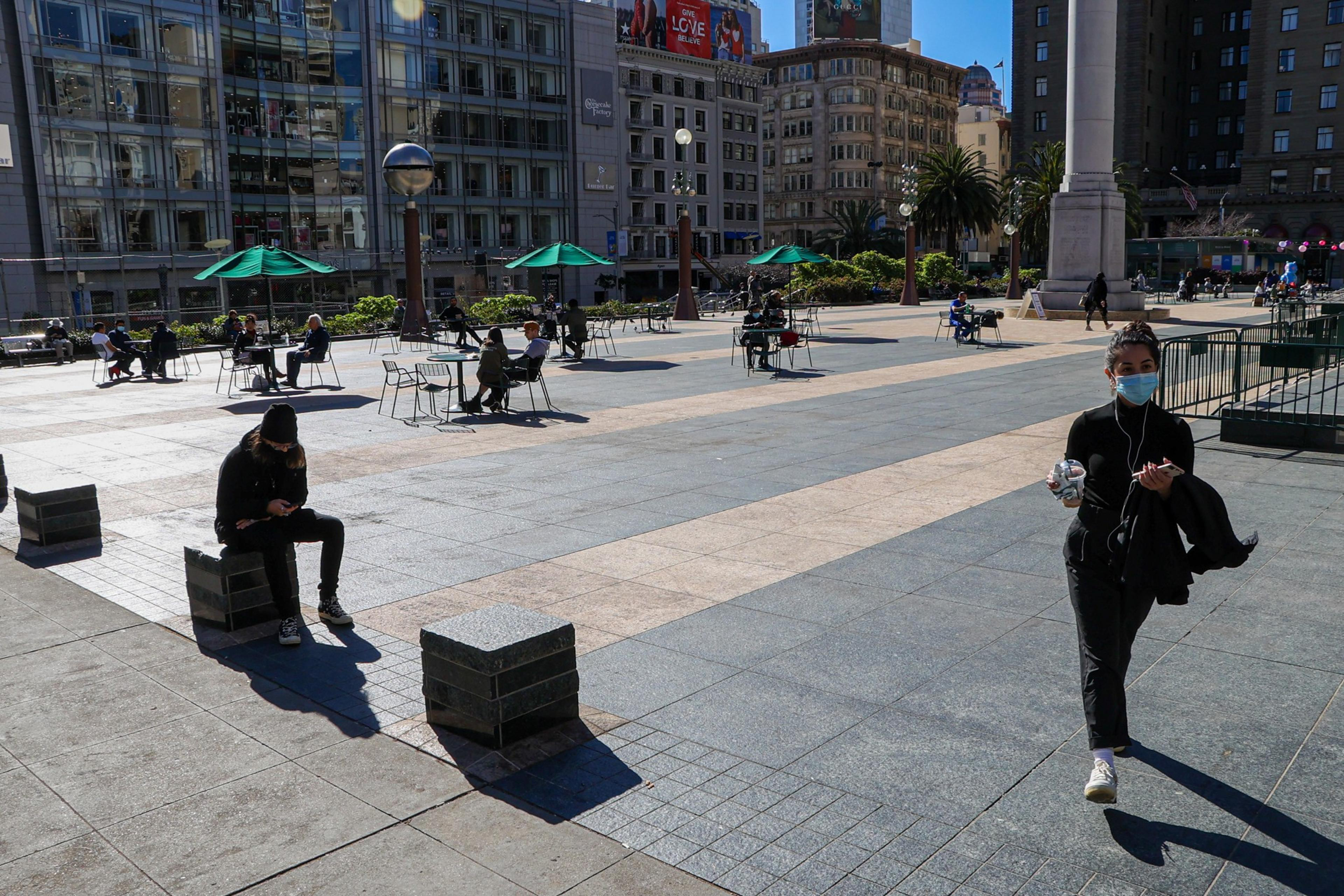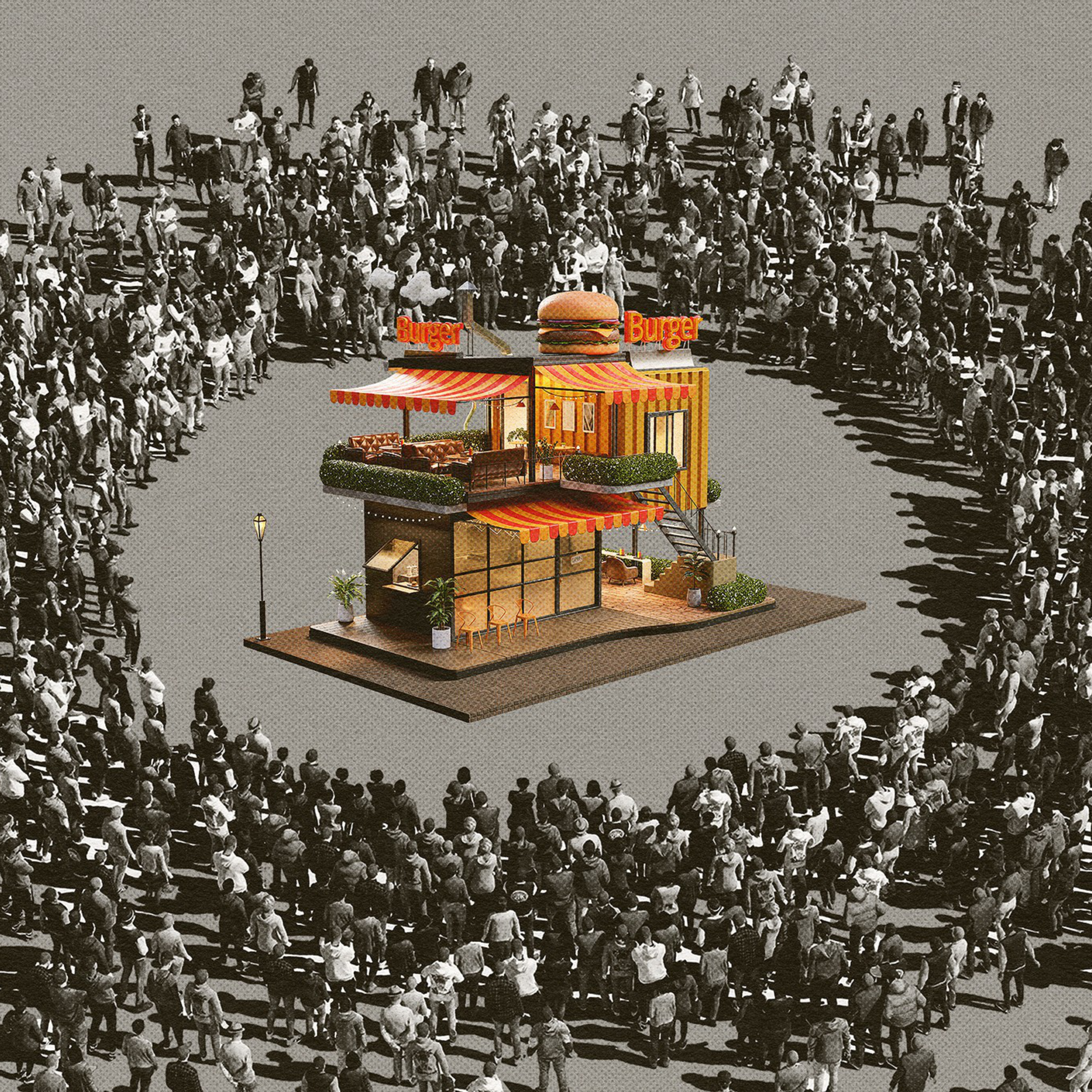The opening day of B. Patisserie’s new location in Union Square felt special-ordered. On that Friday morning (auspiciously, it was the day after the spring equinox) the iconic plaza was noticeably cleaned up in preparation for the annual tulip festival. The sun was out and the birds in the fat palm trees facing the corner of Powell and Geary — soon to house a big Nintendo store — were chatting over the rumbling of double-decker buses beckoning tourists, of which there were plenty. The Game Developers Conference had brought in about 30,000 of them.
B. Patisserie’s opening didn’t draw a line like the previous week’s debut of Ariscault a few miles east at the Mission Rock development. But there was a steady stream of customers, all happy to grab a coffee and a chocolate-banana-almond croissant and sit on the glassed-in patio. The statue of the goddess Nike, who looms above the square, seemed like she might finally have a victory in hand.
Let’s hope so. We all want a win for San Francisco right now, particularly in the neighborhood that’s always been essential for the city’s tourism industry, which did not have a good 2024. Everyone — from our ribbon-cutting-happy mayor to the Union Square Alliance — is trying to resuscitate the vacancy-riddled corridor that cycles visitors from Union Square to Moscone Center (one realtor told me it’s called “the spine”; Mayor Daniel Lurie prefers the more prosaic “hospitality zone”). The multipronged plan of attack includes getting workers back in offices, ensuring the area is clean and safe, drawing people in with activities (juggling lessons (opens in new tab), anyone?), and hopefully, convincing more conferences to commit.


“San Francisco is open for business, that is the message we are sending,” Lurie said at a February press conference touting a bill that could bring 20 new bars and restaurants to the area by making new low-cost liquor licenses available. Lurie is also launching something deemed “Permit SF,” a multi-agency coalition to help small businesses open easier and faster, something restaurants desperately need.
With most Union Square retailers having decamped to online-only — or to still-thriving suburban-style malls like Stonestown and the Stanford Shopping Center — restaurants seem the obvious next choice when it comes to filling empty storefronts. In fact, San Francisco is pinning a lot of hope on food as a panacea. Yes, there’s talk of other options — I’ve heard a lot of nebulous pitches for “experiential concepts” like escape rooms and shopping-eating hybrids à la Eataly. There have been proposals for Legoland and pickleball courts. And, of course, gyms and hair salons seem to be eternal lease-seekers. But restaurants are the most frequent answer to the problem of what to do with an emptied out downtown. They build community and are both practical (we’ve all gotta eat) and a destination experience of their own sort. We are also a city famous for them.
However, can the onus of saving the city be placed on an industry that is extraordinarily tender to the touch right now? As I wrote last week, restaurant closings are the new openings in this town.
Regardless, it seems every developer and realtor is full-steam ahead, creating a dining monocrop. At Thrive City, the food plaza surrounding Chase Center, they’ve pulled in name-brand establishments like Burma Love, Che Fico, and Senor Sisig. Mission Rock, the Giants’ new greenspace-office-condo-restaurant spread near Oracle Park, will include hot dog-concept Quik Dog by Trick Dog and an outpost of SF-born chain Ike’s Love & Sandwiches.


Even Kurt Grundman, a managing partner of the commercial real estate brokerage Lockehouse — the guy largely responsible for successfully filling the Metreon with chains like Nick the Greek and West Coast Sourdough — agrees downtown needs more retail biodiversity. “The majority of the city’s restaurants are suffering right now — cost of goods have gone up, labor has gone up,” Grundman says. “How are we going to support even more?”
For the most part, we have yet to find out if it’s too much, too soon. But Saluhall, the 23,000 square-foot, 450-seat IKEA-adjacent food court that opened exactly a year ago is a current cautionary tale.
The project launched in March of last year with a leap and a prayer, opening on the forever-beleaguered stretch of mid-Market. To make the bet even more high stakes, Saluhall decided to only serve plant-based food — honorable from an environmental standpoint, but questionable as a business tactic. Then came the not-so-shocking news: By March 20, only seven of the original 11 vendors were going to remain, The Chronicle reported (opens in new tab). After the original buzz died down, the number of customers dwindled significantly. As a Hail Mary, some cow was allowed: In January, popular smashburger spot Smish Smash joined the roster. But even though the burgers have been popular, they can’t save the food court alone. As Mounir Bahloul, the owner of Algerian eatery Kayma, which is closing, told The Chronicle, “If there’s no foot traffic, there’s no sales.”
This is where the chicken-or-egg conundrum could come for Union Square as well. While you probably can start to attract people without simply adding more restaurants, you definitely can’t sustain restaurants without people.


This is because restaurants are a whole different animal from other retail operations. Unlike, say, a clothing store, which only takes a few employees to do the folding and the hawking, full-service restaurants require a small village: dishwashers, prep cooks, chefs, bussers, servers, and bartenders. They are also astonishingly expensive to build out, especially in our permit- and inspection-obsessed city. For instance, Corzetti, a stylish, year-and-a-half old Italian restaurant located just down from the forthcoming Nintendo store, cost $1 million to design, despite the fact that the kitchen was already move-in ready. With this kind of investment, the minute you open, you need maximum butts in seats.
And it doesn’t matter how pretty a restaurant is if the flow of customers is spotty. Corzetti owner Adriano Paganini, arguably one of the most successful restaurateurs in San Francisco, says running the Union Square-adjacent restaurant has been incredibly tough. Though it’s busy when there’s a conference in town or a hot play is being staged at the American Conservatory Theater across the street, the dearth of potential customers roaming the neighborhood has meant that business is rarely consistent enough to be able to staff the restaurant properly.
Paganini’s not imagining things. Foot traffic in Union Square was down 9.2% last year after being up 3.4% in 2023. Laurie Thomas, executive director of the SF’s restaurant lobby the Golden Gate Restaurant Association, empathizes with the restaurateur’s plight. “If you’re in an area that’s not busy, you’re going to lose money until there are customers,” she says. “Someone has to help you pay for that until you get the critical mass back. You need a runway.” In fact, there are conversations happening right now with this model in mind, Thomas says, with owners perhaps tapping the private sector to assist with a forgivable loan or a grant that would help restaurants operate until they get to a sustainable level.

A runway is exactly how B. Patisserie, which is owned by award-winning pastry chefs Belinda Leong and Michel Suas, was beckoned to post up in Union Square. It swooped in to replace one of the two Miller & Lux cafes that Tyler Florence had opened on the plaza, then abruptly pulled out of in February, right before NBA All-Star Game weekend. Though Florence was given 8 months of free rent by the Office of Economic and Workforce Development and a $440,000 grant from the Recreation and Parks Department to get the two businesses up and running, he reported business was so slow that he bled out $300,000. Continuing on for any longer was financially untenable. This was reported as a scandal by multiple local publications. Soleil Ho of The Chronicle weighed in to say that maybe a beloved al pastor vendor would have fared better.
Apparently, everyone read those articles. As I sat in Union Square last week, my lap full of buttery shards from a raspberry-rhubarb kouign-amann, a guy walked by with his friends and stopped in his tracks briefly, excited to see that B. Patisserie had taken over the kiosk. “Apparently, the city gave free rent to Tyler Florence,” he said with a conspiratorial whisper, clearly disapproving.
But B. Patisserie is also getting six months of free rent and a good lease — a temporary, yearlong agreement. Leong knows she’s going to need more than just tourists to make the cafe work. (She even admitted to me that she hadn’t been to Union Square in ages herself.) Until the tourists start flowing, the denizens of SF are going to need to step up — for her patisserie and all our city’s restaurants. “If we don’t get locals, we won’t succeed,” she said. It would be great to think she won’t need an on-ramp at all.

